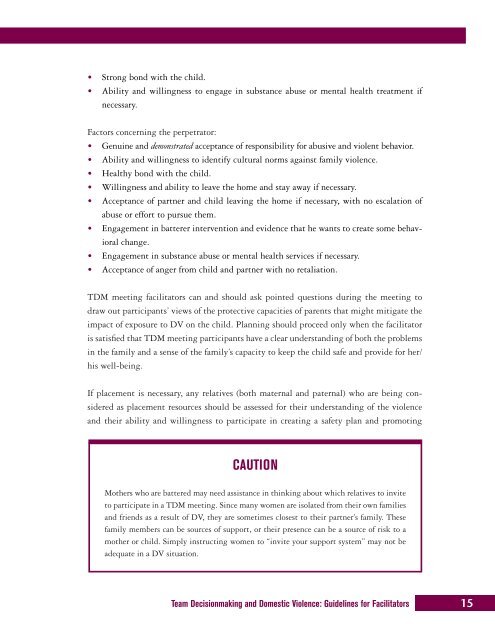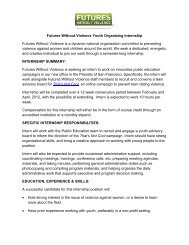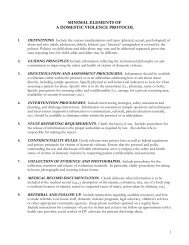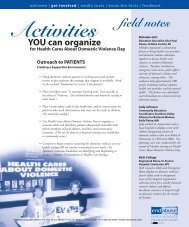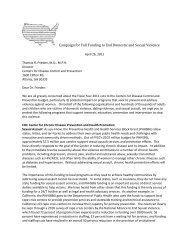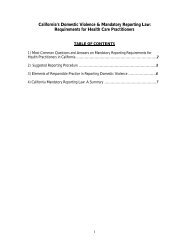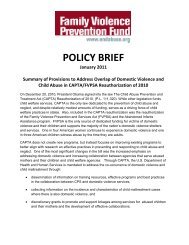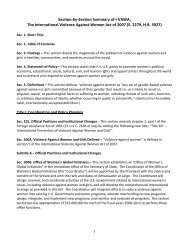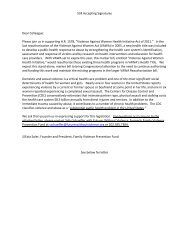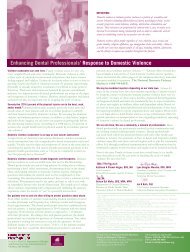Team Decisionmaking and Domestic Violence: Guidelines for ...
Team Decisionmaking and Domestic Violence: Guidelines for ...
Team Decisionmaking and Domestic Violence: Guidelines for ...
You also want an ePaper? Increase the reach of your titles
YUMPU automatically turns print PDFs into web optimized ePapers that Google loves.
• Strong bond with the child.<br />
• Ability <strong>and</strong> willingness to engage in substance abuse or mental health treatment if<br />
necessary.<br />
Factors concerning the perpetrator:<br />
• Genuine <strong>and</strong> demonstrated acceptance of responsibility <strong>for</strong> abusive <strong>and</strong> violent behavior.<br />
• Ability <strong>and</strong> willingness to identify cultural norms against family violence.<br />
• Healthy bond with the child.<br />
• Willingness <strong>and</strong> ability to leave the home <strong>and</strong> stay away if necessary.<br />
• Acceptance of partner <strong>and</strong> child leaving the home if necessary, with no escalation of<br />
abuse or ef<strong>for</strong>t to pursue them.<br />
• Engagement in batterer intervention <strong>and</strong> evidence that he wants to create some behavioral<br />
change.<br />
• Engagement in substance abuse or mental health services if necessary.<br />
• Acceptance of anger from child <strong>and</strong> partner with no retaliation.<br />
TDM meeting facilitators can <strong>and</strong> should ask pointed questions during the meeting to<br />
draw out participants’ views of the protective capacities of parents that might mitigate the<br />
impact of exposure to DV on the child. Planning should proceed only when the facilitator<br />
is satisfied that TDM meeting participants have a clear underst<strong>and</strong>ing of both the problems<br />
in the family <strong>and</strong> a sense of the family’s capacity to keep the child safe <strong>and</strong> provide <strong>for</strong> her/<br />
his well-being.<br />
If placement is necessary, any relatives (both maternal <strong>and</strong> paternal) who are being considered<br />
as placement resources should be assessed <strong>for</strong> their underst<strong>and</strong>ing of the violence<br />
<strong>and</strong> their ability <strong>and</strong> willingness to participate in creating a safety plan <strong>and</strong> promoting<br />
CAUTION<br />
Mothers who are battered may need assistance in thinking about which relatives to invite<br />
to participate in a TDM meeting. Since many women are isolated from their own families<br />
<strong>and</strong> friends as a result of DV, they are sometimes closest to their partner’s family. These<br />
family members can be sources of support, or their presence can be a source of risk to a<br />
mother or child. Simply instructing women to “invite your support system” may not be<br />
adequate in a DV situation.<br />
<strong>Team</strong> <strong>Decisionmaking</strong> <strong>and</strong> <strong>Domestic</strong> <strong>Violence</strong>: <strong>Guidelines</strong> <strong>for</strong> Facilitators 15


